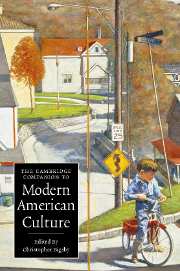Book contents
- Frontmatter
- 1 Introduction: What, then, is the American?
- 2 The American century
- 3 The regions and regionalism
- 4 Immigration to the United States in the twentieth century
- 5 Religion in the United States in the twentieth century: 1900-1960
- 6 Shifting boundaries: religion and the United States: 1960 to the present
- 7 The Hispanic background of the United States
- 8 African Americans since 1900
- 9 Asian Americans
- 10 Women in the twentieth century
- 11 Queer America
- 12 The United States, war, and the twentieth century
- 13 The culture of the Cold War
- 14 Secret America: the CIA and American culture
- 15 Vietnam and the 1960s
- 16 New York City and the struggle of the modern
- 17 Music: sound: technology
- 18 African American music of the twentieth century
- 19 Hollywood cinema
- 20 Popular culture
- 21 Theatre
- 22 Society and the novel in twentieth-century America
- 23 “Preferring the wrong way”: mapping the ethical diversity of US twentieth-century poetry
- Index
- Series List
17 - Music: sound: technology
Published online by Cambridge University Press: 28 January 2007
- Frontmatter
- 1 Introduction: What, then, is the American?
- 2 The American century
- 3 The regions and regionalism
- 4 Immigration to the United States in the twentieth century
- 5 Religion in the United States in the twentieth century: 1900-1960
- 6 Shifting boundaries: religion and the United States: 1960 to the present
- 7 The Hispanic background of the United States
- 8 African Americans since 1900
- 9 Asian Americans
- 10 Women in the twentieth century
- 11 Queer America
- 12 The United States, war, and the twentieth century
- 13 The culture of the Cold War
- 14 Secret America: the CIA and American culture
- 15 Vietnam and the 1960s
- 16 New York City and the struggle of the modern
- 17 Music: sound: technology
- 18 African American music of the twentieth century
- 19 Hollywood cinema
- 20 Popular culture
- 21 Theatre
- 22 Society and the novel in twentieth-century America
- 23 “Preferring the wrong way”: mapping the ethical diversity of US twentieth-century poetry
- Index
- Series List
Summary
An overview
America, Gertrude Stein declared, was “the oldest country in the world because . . . America created the twentieth century” - not through art or literature, one infers, but through industry and invention. Thus it was Thomas Alva Edison, arguably, who inaugurated modernism in America. He electrified the country, he changed night into day - and he transformed sound for ever.
Before Edison's phonograph, sound was ephemeral: something heard could not be heard again. True, certain sounds - music - could be documented in written scores; but such artifacts merely traced experiences that truly existed only in the moment. Recordings changed all that; and by making sound permanent, they altered music's very nature. “Modern” music, then, is in large part the story of sound technology, of its consequences, and of the responses by musicians and listeners.
In the beginning, recordings were mechanical. A reverse megaphone focused sound waves onto a diaphragm to which was attached a stylus; this etched an image of the sound onto a cylinder. To hear the recording, the process was reversed. There was nothing electrical, nothing chemical: the mechanism was wholly consistent with the technology for musical instruments, which took the relatively small sounds produced by an agitated string, a reed, or buzzing lips, and rendered them audible over a substantial distance. The gramophone differed only in that the sound source was a diaphragm activated by a needle driven by grooves in wax.
- Type
- Chapter
- Information
- The Cambridge Companion to Modern American Culture , pp. 332 - 353Publisher: Cambridge University PressPrint publication year: 2006



